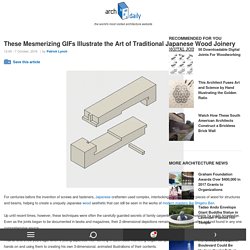

8 Short Architectural Texts You Need To Know. 50 Downloadable Digital Joints For Woodworking. 50 Downloadable Digital Joints For Woodworking If you were captivated by these animations of traditional Japanese woodworking joints, here's a chance to try out some intricate joinery techniques for yourself.

In the spirit of open access to information, professor Jochen Gros and designer Friedrich Sulzer headed up a research project at the C...Lab of the Hochschule für Gestaltung Offenbach in Germany, where they have developed 50 different wood joinery techniques capable of being fabricated digitally, using tools such as a CNC mill or lasercutter. Now these files have been made accessible to the public via downloadable files in various data formats (including several Autocad capable formats). They have also provided each joint with a PDF guide to assembly, to make piecing together the wood elements a snap. On his site, Gros explains why architects & designers may be so fascinated with joinery: You can find a link to the files and contact info for submissions, here. News via Flexible Stream.
These Mesmerizing GIFs Illustrate the Art of Traditional Japanese Wood Joinery. These Mesmerizing GIFs Illustrate the Art of Traditional Japanese Wood Joinery For centuries before the invention of screws and fasteners, Japanese craftsmen used complex, interlocking joints to connect pieces of wood for structures and beams, helping to create a uniquely Japanese wood aesthetic that can still be seen in the works of modern masters like Shigeru Ban.

Up until recent times, however, these techniques were often the carefully guarded secrets of family carpentry guilds and unavailable for public knowledge. Even as the joints began to be documented in books and magazines, their 2-dimensional depictions remained difficult to visualize and not found in any one comprehensive source.
That is, until a few years ago, when a young Japanese man working in automobile marketing began compiling all the wood joinery books he could get his hands on and using them to creating his own 3-dimensional, animated illustrations of their contents. News via Spoon & Tamago. 121 Definitions of Architecture. There are at least as many definitions of architecture as there are architects or people who comment on the practice of it.

While some embrace it as art, others defend architecture’s seminal social responsibility as its most definitive attribute. To begin a sentence with “Architecture is” is a bold step into treacherous territory. And yet, many of us have uttered — or at least thought— “Architecture is…” while we’ve toiled away on an important project, or reflected on why we’ve chosen this professional path.
Most days, architecture is a tough practice; on others, it is wonderfully satisfying. Perhaps, though, most importantly, architecture is accommodating and inherently open to possibility. This collection of statements illustrates the changing breadth of architecture’s significance; we may define it differently when talking among peers, or adjust our statements for outsiders. 1. 2. 3. 4. 5. 6. 7. 8. 9. 10. 11. 12. 13. 14. 15. 16. 17.
Why Architecture Isn't Art (And Shouldn't Be) Why Architecture Isn't Art (And Shouldn't Be) In recent years, there has been a lot of discussion about what architecture's ultimate purpose might be - with answers ranging from the creation of form to the correction of societal ills.

But according to Lance Hosey, perhaps the least useful definition currently in circulation is that architecture is "art. " In this article, originally posted to his blog on the Huffington Post, Hosey argues that the concept of architecture as a form of art is not only misleading to the public, but also potentially damaging to society. In July, I wrote that when architects use the bodies of specific women such as Marilyn Monroe or Beyoncé as "inspiration" for buildings, they objectify both women and architecture.
Many readers didn't like this: "Anyone complaining about where an artist gets thier [sic] inspiration dosn't [sic] understand what an artist or art is," protested one. Huffington Post readers aren't alone in this view, of course.